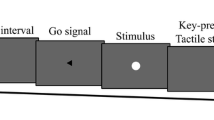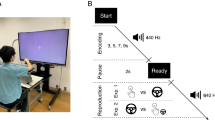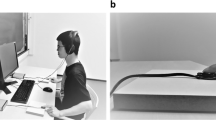Abstract
In a previous study we explored auditory chronostasis and suggested an arousal account of this temporal illusion rather than one dependent on backdating actions to the onset of a motor event. Here we present three experiments designed to distinguish between two competing accounts of the mechanisms underlying the illusion. Experiment 1 investigated whether voluntary movements are necessary for the illusion to occur. Experiment 2 sought to clarify whether auditory chronostasis occurs when the intervals to be judged are continuous (temporally contiguous) rather than separate events. Experiment 3 was designed to establish whether increased task demands account for the illusion. Together the results from these experiments show that chronostasis is an illusion that is not dependent on voluntary action, can occur without a change in the spatial location of the stimulus (thus precluding an account based on spatial attention), occurs with discrete as well as continuous events, and is affected by the salience of the termination of the event to be timed rather than the onset. Collectively these findings suggest that the mechanisms underlying chronostasis are best explained by an arousal hypothesis since neither attention nor backdating to action can account for the commonalities between chronostasis in the auditory, visual and tactile domains.






Similar content being viewed by others
References
Hodinott-Hill I, Thilo KV, Cowey A, Walsh V (2002) Auditory chronostasis: hanging on the telephone. Curr Biol 12:1779–1781
Ivry R (1997) Cerebellar timing systems. Int Rev Neurobiol 41:555–573
Ivry RB, Keele SW, Diener HC (1988) Dissociation of the lateral nad medial cerebellum in movement timing and movement execution. Exp Brain Res 73:167–180
Libet B, Wright EW Jr, Feinstein B, Pearl DK (1979) Subjective referral of the timing for a conscious sensory experience: a functional role for the somatosensory specific projection system in man. Brain 102:193–224
Libet B, Gleason CA, Wright EW, Pearl DK (1983) Time of conscious intention to act in relation to onset of cerebral activity (readiness-potential). The unconscious initiation of a freely voluntary act. Brain 106:623–642
Nichelli P, Always D, Grafman J (1996) Perceptual timing in cerebellar degeneration. Neurpsychologica 34:863–871
Park J, Schlag-Rey M, Schlag J (2003) Voluntary action captures perceived duration of nits sensory consequence. Exp Brain Res 149:530–534
Penney TB, Gibbon J et al (2000) Differential effects of auditory and visual signals on clock speed and temporal memory. J Exp Psychol Hum Percept Perform 26:1770–1787
Ramsayer TH (1993) On dompamionergic modulation of temporal information processing. Biol Psychol 36:209–22
Rose D (1992) How long does it last for you? An illusion of duration. Ophthalmic Physiol Opt 12:93
Rose D, Summers J (1995) Duration illusions in a train of visual stimuli. Perception 24:1177–1187
Rousseau L, Rousseau R (1996) Stop-reaction time and the internal clock. Percept Psychophys 58:434–448
Theoret H, Hague J, Pascual-Leone A (2001) Increased variability of paced finger tapping accuracy following repetitive magnetic stimulation of the cerebellum in humans. Neurosci Lett 306–:29–32
Treisman M (1963) Temporal discrimination and the indifference interval: implications for a model of the internal clock. Psychol Monogr 77:1–31
Tyrell RA, Owens DA (1988) A rapid technique to assess the resting states of the eye and other threshold phenomena: the modified binary search (MOBS). Behav Res Methods Instrum Comput 20:137–141
Walsh V (2003) A theory of magnitude: common cortical metrics of time space and quantity. Trends Cogn Sci 7:483–488
Wearden JH (1999) “Beyond the fields we know...”: exploring and developing scalar timing theory. Behav Processes 46:25–38
Yarrow K, Rothwell JC (2003) Manual chronostasis: tactile perception precedes physical contact. Curr Biol 13:1134–1139
Yarrow K, Haggard P, Heal R, Brown P, Rothwell J (2001) Illusory perceptions of space and time preserve cross-saccadic perceptual continuity. Nature 414:302–305
Author information
Authors and Affiliations
Corresponding author
Additional information
Supported by the Royal Society, Medical Research Council, Wellcome Trust, and McDonnel Pew Foundation.
Rights and permissions
About this article
Cite this article
Alexander, I., Thilo, K.V., Cowey, A. et al. Chronostasis without voluntary action. Exp Brain Res 161, 125–132 (2005). https://doi.org/10.1007/s00221-004-2054-3
Received:
Accepted:
Published:
Issue Date:
DOI: https://doi.org/10.1007/s00221-004-2054-3




